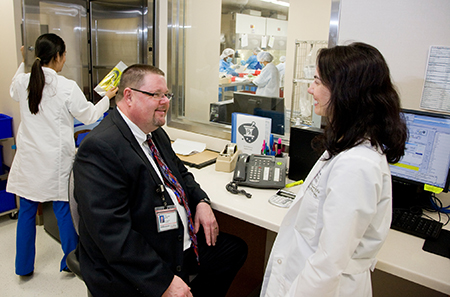Pharmacists ramp up efforts to counter drug shortages

Health care organizations in the United States continue to face national shortages of medicines used to alleviate pain, prepare patients for surgery (anesthetics) and treat diseases like cancer.
MD Anderson has fared better than many organizations in obtaining supplies but is not immune to national shortages of injectable chemotherapy drugs.
“While the majority of patients are not affected, there’s a small subset of patients who are,” says Joel Lajeunesse, vice president for pharmacy. “They need to know we’re doing everything possible to keep the shortage from impacting their care in any way. If we can’t prevent the shortage, we’re finding the most suitable drug alternative to give them the best possible outcome.”
Shortages have been triggered by problems in the manufacturing industry. Some manufacturers contend with their own shortages of raw materials, while others have stopped production lines because of quality concerns or for financial reasons. Not all of them have found it viable to return to production.
MD Anderson purchases a significant volume of the nation’s cancer medications and works only with reputable wholesalers. In some instances, shortages are temporary and the institution can borrow supplies from neighboring hospitals in the Texas Medical Center.
“With many legitimate wholesalers, there’s an allocation system,” Lajeunesse explains. “If you normally buy 80% of a product, you’re likely to get 80% of whatever supply they have. It helps us at MD Anderson because oncology treatments are what we do. We tend to get a larger share of the first new releases.”
Staying ahead of shortages
In the case of cytarabine, pharmacists at MD Anderson averted the shortage by buying supplies ahead of time. This is a markedly different approach from the past when hospitals sought to maintain just-in-time inventory.

Joel Lajeunesse, vice president for pharmacy, and Kelley
Reece, charge pharmacist for the Ambulatory Treatment
Center, discuss technologies being developed that could
enhance pharmacy production and efficiency.
Photo: John Everett
“Once you realize a drug has a potential supply issue, you have to abandon that model and do what you can to procure a steady stream of that drug,” Lajeunesse says. “If it means buying multiple days or a larger purchase, assuming it’s available, you do those things until you see the supply for that drug has stabilized.”
MD Anderson has established a dedicated team of pharmacists, called drug information clinical pharmacy specialists, to monitor potential shortages and alert physicians to the probable impact.
Wendy Heck, Pharm.D., who leads the team, has seen the number of national drug shortages steadily climb during the past five years. Nearly 30% of all shortages currently involve oncology medications.
“The drug information team meets weekly to assess the pharmaceutical environment,” Heck says. “When a drug situation escalates beyond a temporary or easily addressed shortage, we conduct a clinical assessment to explore safe and effective substitutions.”
Physicians are brought into the conversation through the pharmacy and therapeutics committee, which meets monthly to ensure the safe, rational and effective use of medications at MD Anderson.
“Safety of patients is number one,” says committee chair John Araujo, M.D., Ph.D., assistant professor in the Department of Genitourinary Medical Oncology. “We have a lot of people monitoring shortages and watching what is going on both nationally and internationally.”
In the fall, the committee selected epirubicin as an effective though expensive alternative to doxorubicin for treating breast and other cancers. The shortage was temporary and has since been resolved with imported supplies.
But in shortages of other drugs like etoposide, which is used to treat testicular cancer, it’s proven more difficult to find equally effective substitutions. This also was a longer-term shortage, requiring therapy changes by physicians.
That’s where multidisciplinary expertise is especially valuable, Araujo says.
MD Anderson has experts working collaboratively in all fields of oncology to provide the best courses of treatment for patients.
Knowledge sharing also goes on between the physicians and pharmacists. The drug information team maintains an intranet site that displays which medications are sufficiently available at MD Anderson, potentially limited or altogether unavailable.
Keeping the supply chain unspoiled
In October, the government gave the U.S. Food and Drug Administration (FDA) greater authority to obtain advance notifications from drug manufacturers of expected shortages.
It also has loosened regulations for the temporary importation of the pharmaceutical equivalent of doxorubicin and for preservative-free methotrexate, which is used to treat pediatric leukemia.
The new supplies are deemed to be of adequate quality to enter the U.S. supply chain.
If shortages weren’t enough, the FDA is also investigating reports of counterfeit cancer medications such as bevacizumab (marketed in the United States as Avastin®) entering the national supply chain.
Avastin was never in short supply, but some grey market distributors find profitability in selling ineffective imitations of the prescription medication.
MD Anderson never works with grey market distributors, says the pharmacy team, which nevertheless checked — and found safe — the integrity of the institution’s Avastin supplies.













